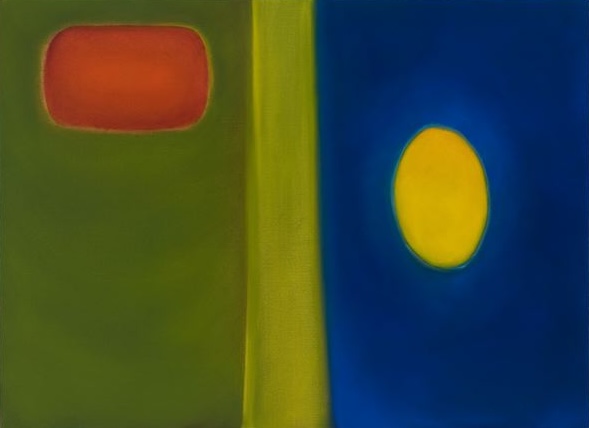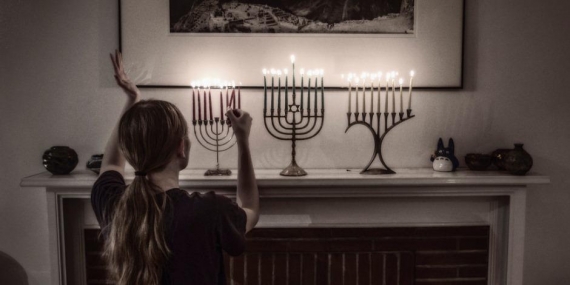Goal:
To assist families in marking and making a pivotal recurring transition. To enable healing while strengthening and verbalizing the importance of parent/child relationships in the context of transferring custody of children between two parents.
Introduction:
This ritual acknowledges the separation that takes place in the modern experience of custody in separation and divorce agreements. In this circumstance there is much that can be done to ease the anguish of this psychologically complicated instance, whether it takes place at a rest stop, restaurant doorstep, or through a third party.
Rituals of separation instruct us: At the conclusion of Shabbat there is the ritual of havdalah. During this ritual we hold our hands up to the flame to see the difference between the light and the darkness created in the shadows. The Shulkhan Arukh (Yoreh Deah 357:1) suggests that this motion of holding our hands up to the flame also affords us the chance to see our fingernails. Our nails grow slowly and their growth is sometimes unnoticed. By holding them up and inspecting them we can see the subtle changes that have occurred to us. This moment of transition has wonderful lessons for us.
What are the changes that occur within us and by us through the interactions we have with our loved ones? We must ask the questions of how have we changed and how have they. We must ask the questions of how are we different and how are they different. What do we want them to know about us; what do they want to us to know? For the young child the changes will be different than for the older child. The young child may have learned new skills in school like new letters and math. For the adolescent the issues may be more social. But either way the changes are significant. The transfer permits us each a chance to be a little different. You may want to create a checklist of subjects of which to keep track. Some subjects that may generate that conversation surround school, social network (friends), and hobbies.
Another tradition instructs us: The Melaveh Malkah is the ritual designed around the conclusion of Shabbat. The conclusion of Shabbat is so difficult. The Melaveh Malkah reminds us that saying “good bye” is hard to do, and we might try to delay it. Sometimes a clean break is easier; sometimes a proper farewell is needed. The Melaveh Malkah helps us make that transition back to the weekday. The time we spend with our children in custody arrangements have the feeling of special time.
Knowing that Shabbat is going to end each week and knowing that a Melaveh Malkah is going to be a part of that experience may help divert attention from the difficult moment. This is similar to the child who goes to the pediatrician and receives a sticker on the way out, learning to associate the office visit with the joy of receiving a small prize.
Unfortunately, these analogous scenarios fall short. There is a difference between “good bye” and “good bye again.” The repetitious nature of these transfers requires a new paradigm, much like the small child who has difficulty going off to sleep at night requires a bedtime ritual. So too, the child going off to the “other parent” requires some ritual. Again our tradition offers us the ritual of Kriyat Shema al hamitah, the recitation of the Shema before going to sleep. Just like going to sleep requires the child to transition to a different state, so too does the transferring to the other parent.
The Ritual:
Preparation: Before leaving to go to exchange custody of a child the custodial parent can do some preparation with the child. The parent can help ready the child for the exchange by gathering money that will be given later to tzedakah. The parent and child can make up a goody bag of food to take for the trip if it is a long one or just to have as a snack later. The parent and child can bake cookies or even hallah that can be eaten later.
During the drive to the exchange is a good time to recap the visit. What were some of the things they enjoyed or that were disappointing? It is also a good opportunity to talk about what they expect both from the other parent as well as the next visit. Finally they should discuss when the next visit will take place. They should be clear on the date, time, and location of the next time they will see each other. They may also want to discuss the next opportunity they will have to speak on the phone or through email.
At the exchange each parent will have a script (this script can be used verbatim for the initial exchange and then altered or abbreviated as the transitions become more routine).
Custodial parent says to the child: Here is a card that has my phone number and email address and on the back is the date, time, and place that I will see you again. Do you have somewhere to put it?
They might add: As I say good-bye today know I love you. I will be there for you when you need me most. I will hold you in my heart just as I hold you in my arms. Even when you are not within my sight, you are in my thoughts.
After the exchange the ride back is a difficult transitional moment for both the parent with the child and the one without. The parent with the child is our initial focus. The parent can ask about expectations of the upcoming visit. The parent can ask: is there something you are looking forward to? Are there things you are nervous about?
When the child is brought into the parent’s home the parent can say: It is wonderful to have you back. As we pass by the mezuzah we can take a moment to realize the safety and holiness of our home together. They can then say: I am committed to keeping this a safe place for you.
The traditional blessing for the home:
בָּזֶה הַבַּיִת לֹא יָבוֹא צַעַר
לֹא תָּבוֹא מַחְלֹקֶת
לֹא תָּבוֹא בֶּהָלַת
Ba’zeh habayit lo yavo tza’ar
Lo tavo makhloket
Lo tavo b’halat.
Through this gate no sorrow will enter
Through this entrance no curse will come
Through this door no fear will pass
In this family no quarrel will appear
In this place will be peace and blessing
After the initial entry into the home there ought to be an opportunity to give the tzedakah the child brought with them.
For the parent who now makes their way back to their home without their children, this is an opportunity to acknowledge the loneliness and sadness. But it is also a time to feel the gratitude born of having the wonderful gift that is their life and the time together. For that reason the recitation of Psalm 91, which has become associated with varied transitions, may be helpful.
He who dwells in the secret place of the most High, who abides under the shadow of the Almighty, Will say to the Lord, My refuge and my fortress, my God, in whom I trust, For he shall save you from the snare of the fowler, and from the noisome pestilence. He shall cover you with his feathers, and under his wings shall you find refuge; his truth shall be your shield and buckler. You shall not be afraid of the terror by night; nor of the arrow that flies by day; Nor of the pestilence that walks in darkness; nor of the destruction that wastes at noonday. A thousand shall fall at your side, and ten thousand at your right hand; but it shall not come near you. Only with your eyes shall you behold and see the reward of the wicked. Because you, O Lord, are my refuge. You have made the most High your habitation; No evil shall befall you, nor shall any plague come near your dwelling. For he shall give his angels charge over you, to keep you in all your ways. They shall carry you up in their hands, lest you dash your foot against a stone. You shall tread on the lion and on the adder; the young lion and the crocodile shall you trample under foot. Because he has set his love upon me, therefore I will save him; I will set him on high, because he knows my name. He shall call upon me, and I will answer him; I will be with him in trouble; I will save him, and honor him. With long life I will satisfy him, and show him my salvation.
Final comment:
This ritual may be used once or many times. It may be used at every transfer or when the leave will be extended, for example when the children are going off for the summer to camp. In this transitional moment we may feel joy and guilt, anger and sadness, all at the same time. This ritual seeks to give language and a framework to those emotions while keeping the moment positive and constructive. We must recognize that different people react differently to the same circumstance, while how an individual reacts affects others in that circumstance. Just like we repeat the story of leaving Egypt over and over every year, we grow to understand more about ourselves with each repetition. Here too, we repeat the activity over and over again, each time learning something about ourselves and the impact we have on others.
Bibliography
Abramowitz, Yosef I., and Rabbi Susan Silverman. Jewish Family and Life: Traditions, Holidays and Values for Today’s Parents and Children. Golden Books, 1997. Accessible book offering Jewish parents a multitude of perspectives on raising Jewish children and bringing Jewish ritual and practice into all aspects of life.
Cardin, Rabbi Nina Beth. The Tapestry of Jewish Time: A Spiritual Guide to Holidays and Life-Cycle Events. Behrman House, 2000. Warmly explains the significance of ancient and modern Jewish rituals for holidays and lifecycle events, including suggestions on how to Jewishly ritualize secular milestones.
Cox, Meg. The Heart of a Family: Searching America for New Traditions that Fulfill Us. Random House, 1998. The author surveys real American families and reports on delightful rituals and traditions they have developed.
Diamant, Anita, and David Cooper. Living a Jewish Life: Jewish Traditions, Customs, and Values for Today’s Families. HarperCollins, 1996. A guide to all aspects of Jewish life, including Sabbath rest and ritual, combining lore, history, quotations, and prayers, with religious approach covering the various liberal movements.
Donin, Hayim Halevy. To Be a Jew. Basic Books, 1972 An Orthodox rabbi surveys Jewish practice and belief in this classic work.
Falk, Marcia. The Book of Blessings: A New Prayer Book for the Weekdays, the Sabbath, and the New Moon Festival. Harper SanFrancisco, 1996. Creative, feminist prayers based on the traditional liturgy, as well as poems for a number of occasions, including Shabbat.
Klein, Isaac. A Guide to Jewish Religious Practice. Jewish Theological Seminary of America, 1979. An extensive guide to halacha (Jewish law) as it relates to religious practice, by a prominent 20th-century Conservative halachic expert.
Lang, Virginia E., and Louise B. Nayer. The Intentional Family: Simple Rituals to Strengthen Family Ties. Quill, 1997. Describes how families can use rituals to strengthen connection, and teach and re-enforce values; very realistic about how rituals develop in families, how parents meet with resistance and how rituals are ultimately implemented.
Strassfeld, Michael and Sharon, Ed. The First, Second and Third Jewish Catalogs. Jewish Publication Society, 1973, 1976, 1980. A far-ranging collection of topics in this do-it-yourself guide to Judaism (now somewhat dated, but still rich and useful) that can help any Jew—whether steeped in tradition or just discovering it—become personally involved in any aspect of Jewish ritual life, customs, and culture. The Third Catalog contains an index to all three books.
Sucov, Ellen B. Fragmented Families. Southern Hills Press, 2006. A wonderful study in the finding the values that underlie families and how to affirm those values in the face of divorce.













